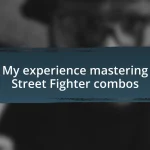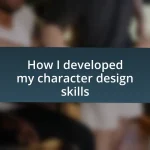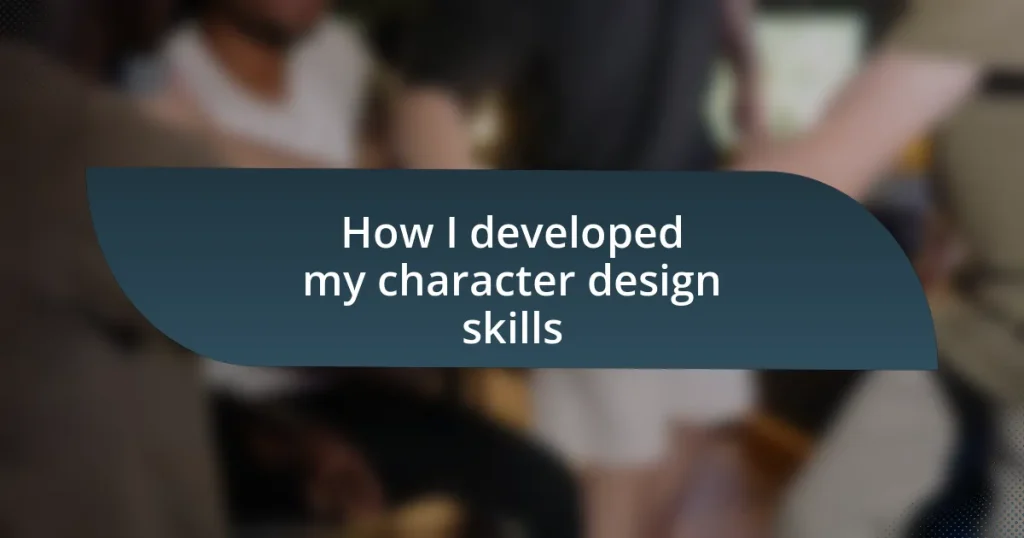Key takeaways:
- Finding inspiration can come from unexpected sources, such as nature, art, and everyday experiences.
- Mastering fundamental design principles like balance, contrast, and proportion enhances character design skills and personal artistic expression.
- Exploring various artistic styles and mediums, such as watercolor and digital art, broadens creative possibilities and refines individual identity.
- Constructive feedback from peers is essential for growth, helping artists improve their work by providing new perspectives on emotional depth and design.
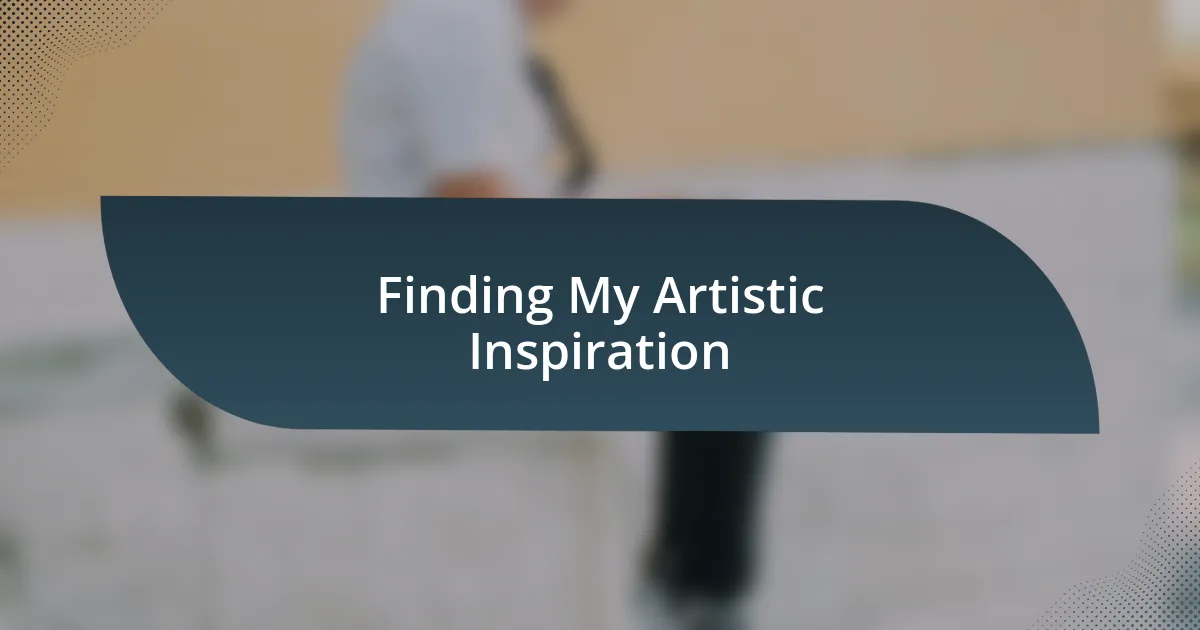
Finding My Artistic Inspiration
Finding artistic inspiration can sometimes feel like chasing shadows. I remember sitting on my bedroom floor, surrounded by sketches, just staring at the walls. The art books I’d collected as a teenager filled my space with excitement, each page revealing new worlds. Do you ever feel that rush when you discover a piece that makes you want to create?
During one particularly uninspired week, I took a long walk in a nearby park, hoping nature would spark something within me. Watching children play, I noticed the wildness of their imaginations—how they transformed a simple stick into a magical wand or a sword. That moment reminded me of the joy and freedom in creation, encouraging me to embrace whimsy and the unexpected.
Sometimes, inspiration strikes when I least expect it. One night, as I watched an old animated film, the vivid character designs and expressive stories reignited my passion. Have you ever had a moment where something seemingly mundane becomes a gateway to creativity? It was a reminder that the world is brimming with inspiration if we remain open to it.
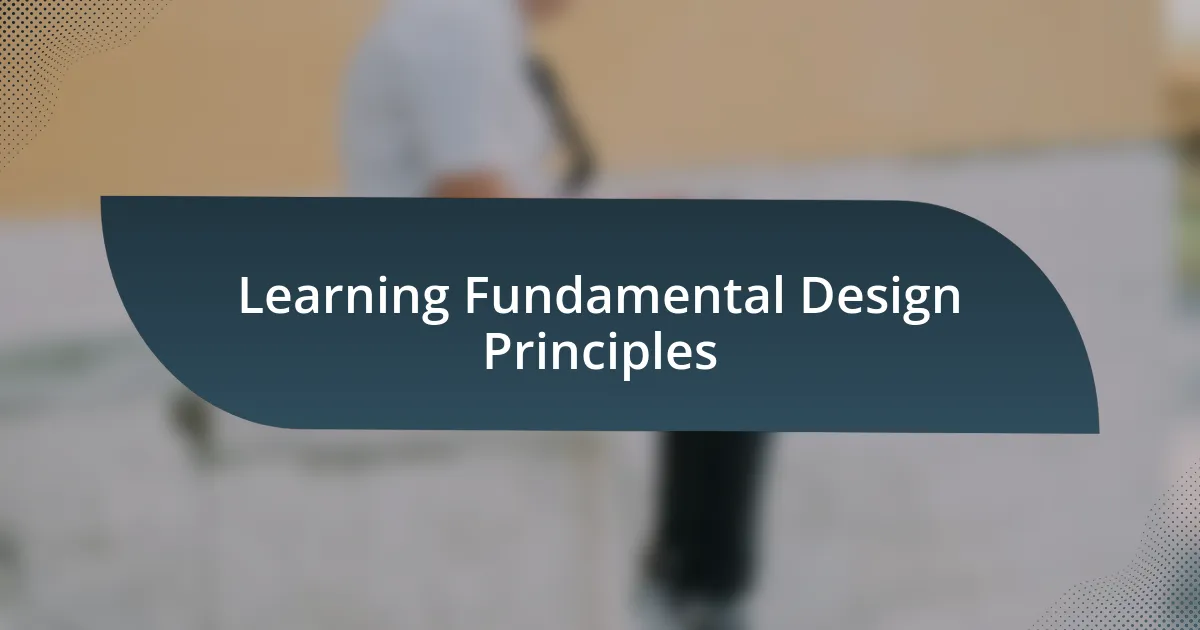
Learning Fundamental Design Principles
Learning the fundamental design principles was a pivotal step in my character design journey. I remember feeling overwhelmed by the wealth of information available, yet excited by the thought of mastering the basics. I started with simple concepts like balance and contrast, which were both eye-opening and liberating. Understanding how elements interact visually not only refined my designs but also deepened my appreciation for what makes a character truly resonate.
Here are some fundamental design principles that I focused on:
- Balance: Distributing elements evenly to create a sense of harmony.
- Contrast: Using differences in color, size, and shape to highlight important features.
- Emphasis: Drawing attention to specific aspects of the design, making them stand out.
- Unity: Ensuring all aspects of the design work together cohesively.
- Proportion: Maintaining appropriate size relationships between different elements for realism.
As I practiced these principles, I noticed how they transformed my work. One day, as I honed in on proportion, I created a character whose oversized head and tiny limbs conveyed playfulness effortlessly. That moment sparked a realization for me: these principles weren’t just rules—they were tools to express ideas and emotions more effectively. Engaging with these fundamentals allowed me to develop a voice in my designs, transforming them from mere sketches into characters that felt alive.
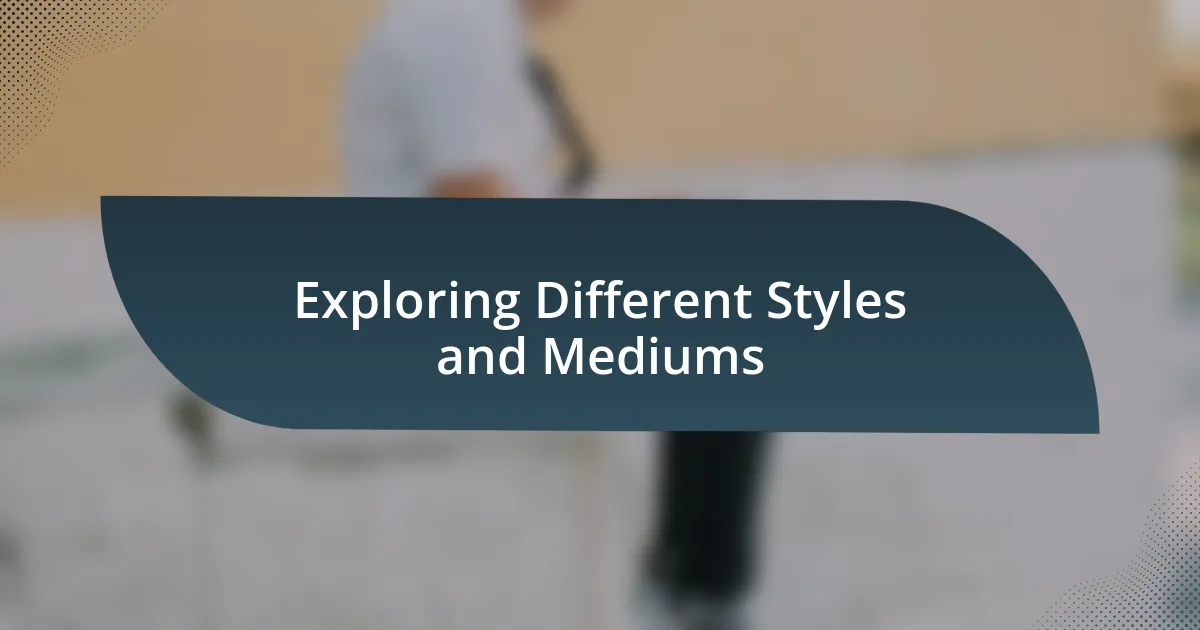
Exploring Different Styles and Mediums
Exploring different styles and mediums is an essential part of developing my character design skills. I vividly remember the first time I experimented with watercolor. The unpredictability of the medium challenged me, but it also unlocked a new realm of creativity. Each brushstroke felt alive, and blending colors became a meditative experience that added depth to my designs. I learned to embrace imperfections, which often resulted in unique textures that made my characters stand out.
I also ventured into digital art, which provided a stark contrast in process and outcome. The precision I could achieve with software like Photoshop was exhilarating. It allowed me to play with layers and effects, crafting intricate details that I struggled to replicate on paper. This transition helped me realize that digital tools could enhance my storytelling, as I could easily adjust elements and experiment with different styles until I found the perfect fit. Each medium taught me valuable lessons about flexibility and adaptation in my creative workflow.
The more I explored various styles—be it manga, realism, or cartoonish renditions—the more my understanding of character design expanded. For instance, I drew inspiration from the exaggerated features in cartoon designs and combined them with the detail-oriented approach of realism. It was a thrilling experience to merge those worlds and create something new. Each exploration felt like a discovery of not just design techniques, but also of my evolving artistic identity.
| Medium | Characteristics |
|---|---|
| Watercolor | Fluid, unpredictable, fosters spontaneity |
| Digital Art | Precise, editable, enhances detail |
| Manga | Exaggerated features, vibrant, expressive |
| Realism | Detailed, proportionate, lifelike |
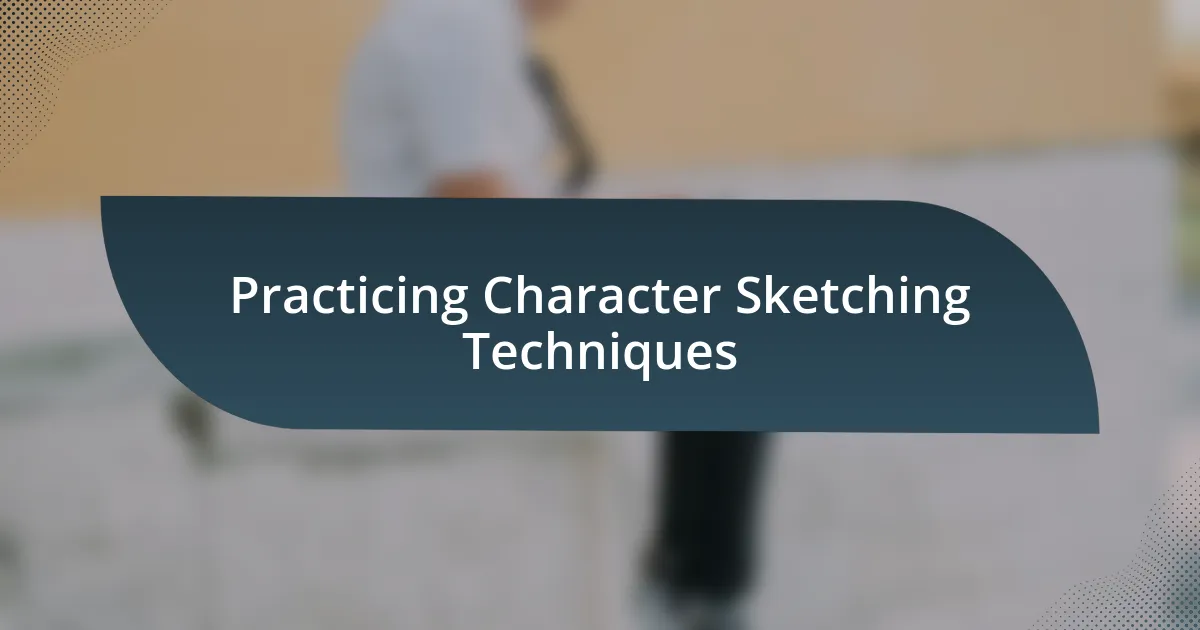
Practicing Character Sketching Techniques
When it comes to practicing character sketching techniques, I found keeping a sketchbook handy was a game-changer. I remember setting aside time every day just to doodle whatever came to mind—without any pressure to create a masterpiece. It was liberating; this practice not only honed my skills but also helped me develop my unique voice. Have you ever felt constrained by expectations? I certainly did, until those early sketches allowed me to break free from that mindset.
One technique that worked wonders for me was gesture drawing. Participating in weekly life drawing sessions pushed me to capture poses quickly, focusing on movement and emotion rather than perfection. The thrill of depicting a fleeting moment in just a few lines was exhilarating! I found that these short sessions sparked inspiration and made me appreciate the beauty in the raw, spontaneous essence of character design.
Additionally, I explored character turnarounds, which helped reinforce my understanding of form and rotation. I vividly recall the first time I completed a full turnaround for a character I had been developing. It was exciting to see my design come to life from different angles, as though I had breathed dimension into my sketches. This practice not only built my technical skills but also deepened my connection with the characters I created, as they evolved beyond flat illustrations into relatable figures with depth and personality.

Receiving Constructive Feedback from Peers
Receiving constructive feedback from peers was a pivotal moment in my character design journey. I remember nervously sharing my work with a group of fellow artists for the first time—my heart raced as they scrutinized my sketches. What surprised me was that their insights, rather than feeling like criticisms, illuminated areas for improvement that I had overlooked, sparking a deeper understanding of my own work.
One particular instance stands out. During one critique session, a peer pointed out that my character lacked emotional depth in their facial expressions. I hadn’t realized it at the time, but that feedback changed how I approached character designs moving forward. It made me more attentive, realizing that conveying emotions visually is just as important as the details of the outfit or pose. Have you ever experienced a shift in perspective from someone else’s feedback? That kind of enlightenment became invaluable to me.
Over time, I embraced the feedback process not just as a way to identify flaws, but as a tool for growth and collaboration. Each time someone offered constructive criticism, I took it as a chance to refine my skills and push my creative boundaries. Instead of feeling defensive, I learned to listen actively. That shift in mindset transformed my work—both technically and emotionally—allowing me to create characters that resonated more profoundly with audiences.
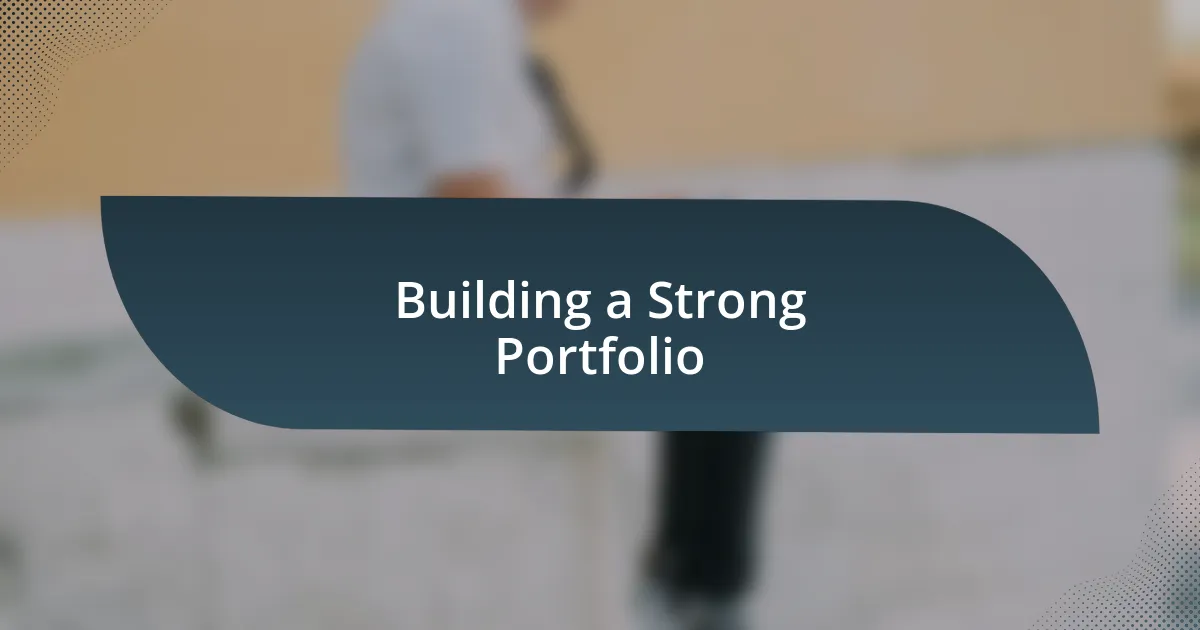
Building a Strong Portfolio
When it comes to building a strong portfolio, I believe it’s crucial to showcase a diverse range of styles and characters. Early on, I realized that my portfolio was not just a collection of work—it was a narrative of my artistic journey. I made it a point to include pieces that highlighted my growth as an artist, from my initial sketches to more refined designs. Have you ever looked back at your early work and cringed a little? I certainly have, but I’ve come to appreciate those earlier pieces as stepping stones.
One effective approach was to create themed projects that demonstrated my ability to conceptualize characters within specific contexts. For instance, I developed a series of characters inspired by folklore, which allowed me to explore various cultural backgrounds while refining my storytelling capabilities. This not only enriched my portfolio but also kept me motivated. Don’t underestimate the power of a cohesive theme in tying your work together and giving potential clients a glimpse of your artistic vision.
I also learned the importance of quality over quantity. Initially, I thought a large portfolio meant I’d make a stronger impression, but I soon realized that curation is key. I became selective, choosing only my best pieces—those that truly represented my skills and creativity. Have you ever pared down your work and felt that sense of liberation? It was freeing for me, and it ultimately led to a more focused portfolio that garnered the attention I was striving for.

Continuing Education and Skill Development
Continuing education has played a significant role in my development as a character designer. I remember attending workshops and online courses where industry professionals shared their techniques and insights. It felt like a lightbulb moment each time I discovered a new method that transformed my approach to design—have you ever experienced that rush of inspiration when learning something that resonates deeply with you?
One of my favorite ways to refine my skills has been through feedback and critiques from peers. Actively engaging in online forums and social media groups created opportunities to share work and receive constructive advice. I can’t stress enough how valuable it is to embrace criticism—it’s like a roadmap for my growth. Have you sought feedback on your work before? The insights I’ve gained have undoubtedly helped elevate my character designs.
Additionally, I’ve embraced the habit of setting specific learning goals. For instance, I focused on mastering anatomy by dedicating time to study human form and facial expressions. This targeted practice not only improved my technical skills but also helped me bring more emotion and depth to my characters. Don’t you find that having clear objectives can turn learning into a more engaging experience? It certainly has for me.

